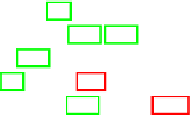Information Technology Reference
In-Depth Information
Ta b l e 3 . 1 4
MP models obtained by LGSS
Belousov-Zhabotinsky, Prigogine's Brusselator (BZ)
Brusselatus ([84, 68], Table 3.9)
Lotka-Volterra, Predator-Prey dynamics (LV)
Volteranus ([89, 116, 78], Table 3.8)
Susceptible-Infected-Recovered Epidemics (SIR)
Epidemicus ([88, 68])
Early Amphybian Mitotic Cycle (AMC)
Mitoticus ([81, 82, 101], Table 3.16)
Drosophila Circadian Rythms (DCR)
Drosophilus ([68])
Non Photochemical Quenching in Photosynthesis (NPQ)
Photochemicus ([110, 107])
Minimal Diabetes Mellitus (MDM)
Mellitus ([105])
Bi-catalytic Synthetic Oscillator
Sirius ([92], Table 3.5)
Circular Synthetic Oscillator
Goniometricus ([100], Table 3.11)
The fundamental mechanism of mitotic oscillations concerns the periodic change
in the activation state of a protein produced by
cdc2
gene in fission yeast or by
homologous genes in other eukaryotes. The simplest form of this mechanism is
found in early amphibian embryos (see [83]). Here cyclin (C) is synthesized at a
constant rate and triggers the transformation of inactive (
M
+
) into active (
M
)
cdc2
protein, which leads to the formation of a complex known as M-phase promoting
factor (
MPF
). MPF triggers mitosis, but at the same time
M
elicits the activation
of a protease from state
X
+
to
X
. The active protease degrades cyclin resulting in
the inactivation of
cdc
2. This brings the cell back to initial conditions and a new
division cycle can take place. The ODE presented on the right of Fig. 3.8 is the
differential model of dynamics described on the left of Fig. 3.7, where
C
,
M
,
X
are
the concentrations of
C
,
M
,
X
, respectively, and 1
−
M
,
1
−
X
are the concentrations
of
M
+
,
X
+
respectively (the definitions of the parameters of the ODE model of
Fig. 3.8 are not simple and are not relevant for our further discussion, however they
can be found in [81]). The regulation maps calculated by LGSS are obtained starting
from a dictionary of 20 possible
regressors
, that is monomials of
C
,
M
,and
X
with
degree less than or equal to 3 (i.e. constants,
C
,
M
,
X
,
C
2
,
M
2
,
X
2
,
CM
,
CX
,
MX
,
C
3
,
M
3
,
X
3
,
C
2
M
,
CM
2
,
C
2
X
,
CX
2
,
M
2
X
,
MX
2
,and
CMX
)
4
.
The 700 MP models that LGSS found for Goldbeter's mitotic oscillator are dis-
tributed into 40 different grammatical schemata. In Table 3.15 other descriptional
indexes of models are given for the first 14 grammatical schemata which define
621 models from a total of 700 (89%). These indexes are useful for discriminating
interesting aspects of the MP grammars and they comprehend:
1. the
number of regressors
;
2. the
total number of monomials
;
3. the
temporal grain
of dynamics observation, which is expressed by the values of
time interval
τ
;
4
Substances
M
+
and
X
+
are not considered because they depend on
M
and
X
respectively.













